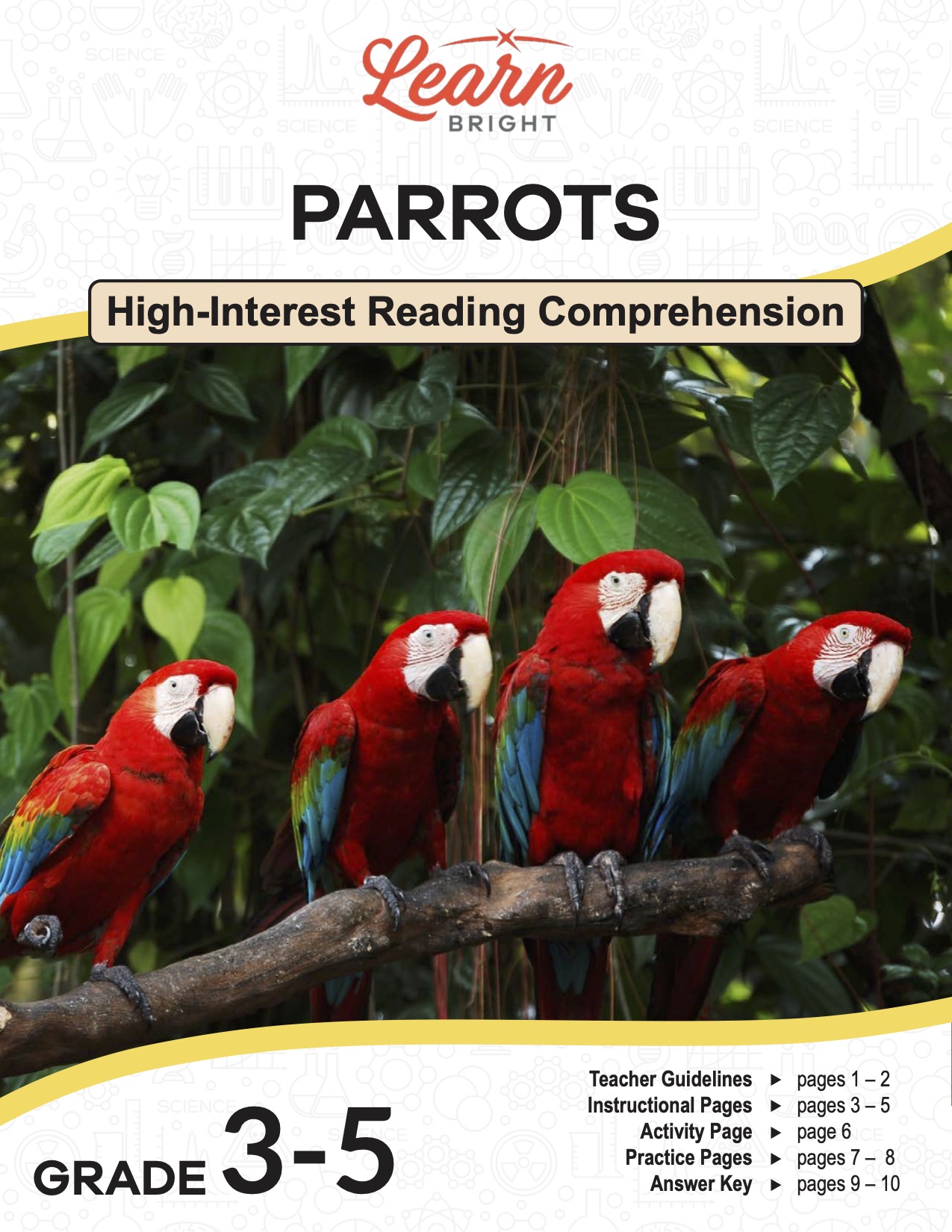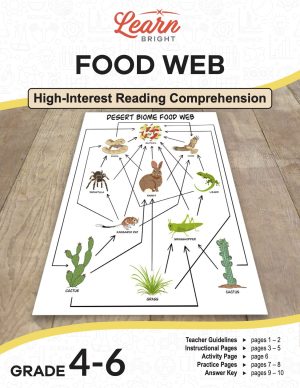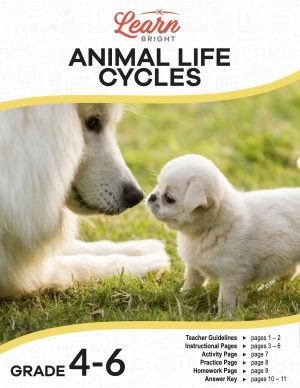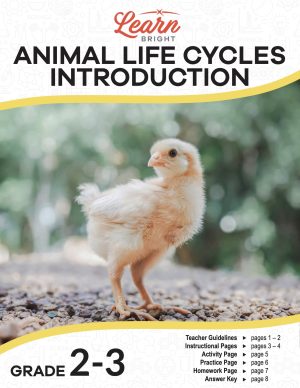Description
What our Parrots lesson plan includes
Lesson Objectives and Overview: Parrots is a high-interest reading comprehension lesson plan. As such, students will practice various close reading and comprehension skills. In addition, they will learn about a parrot’s habitat, diet, and behaviors. This lesson is for students in 3rd grade, 4th grade, and 5th grade.
Classroom Procedure
Every lesson plan provides you with a classroom procedure page that outlines a step-by-step guide to follow. You do not have to follow the guide exactly. The guide helps you organize the lesson and details when to hand out worksheets. It also lists information in the yellow box that you might find useful. You will find the lesson objectives, state standards, and number of class sessions the lesson should take to complete in this area. In addition, it describes the supplies you will need as well as what and how you need to prepare beforehand.
Teacher Notes
The teacher notes page provides an extra paragraph of information to help guide the lesson and remind you what to focus on. It explains that you can teach this lesson in a whole-class setting or as an independent, small-group activity. The blank lines on this page are available for you to write out thoughts and ideas you have as you prepare the lesson.
PARROTS LESSON PLAN CONTENT PAGES
What Is a Parrot?
The Parrots lesson plan contains three content pages. It begins by providing a box of background information about this animal. This group of birds typically live on tropical and subtropical continents. Their diet consists of a mixture of plant and animal foods. They usually live between 40 and 60 years!
Parrots are fascinating birds with their vibrant colors and unique features. They have colorful feathers that make them look like living pieces of art. Their strong beaks are adapted for cracking open nuts and seeds—their favorite meals. Parrots are social creatures and often live in groups called flocks. These flocks are bird families that work together to find food and stay safe from predators.
Parrot feet are designed to help them hold onto branches and perch well. Two of their toes point forward and two point backward. This makes it easy for them to grip onto things, like how you would hold on to a swing at the playground. And guess what? In addition to eating, parrots use their beaks as an extra hand to climb and play. Parrots are like nature’s acrobats, using their feet and beaks to explore their colorful world in the trees!
When caring for their babies, parrots are dedicated, or very supportive, parents. Female parrots lay eggs in nests, and both parents take turns keeping the eggs warm until they hatch. After the chicks are born, the parents feed them a special food called “crop milk,” which is regurgitated from their throats. This nutritious milk helps the chicks grow strong and healthy. As the chicks age, their parents teach them important skills like flying and finding food.
A Parrot’s Diet
Parrots are also nature’s gourmet eaters, and they adapt their meals to their habitat. Depending on where they are, they enjoy a mix of fruits, seeds, nuts, and even flowers. They use their strong beaks to crack open hard shells and peel fruit skins. In the rainforests, parrots munch on tropical fruits. In drier places, they feast on seeds and nuts that give them energy.
But guess what? Some parrots also nibble on leaves. Just as you have different favorite foods, parrots have theirs, too! They love treats such as berries, figs, and sunflower seeds. And they know how to find their favorite meals, whether in a lush jungle or a sunny grassland.
In addition, parrots have a unique way of eating that involves their feet. Just as we use our hands to hold onto things, parrots use their feet like hands to grab and hold their food. Imagine using your feet to pick up your sandwich while you took a bite! Parrots’ feet are strong and agile, with four toes on each foot. Remember, two toes face forward and two face backward. This unique arrangement allows them to grip branches, perches, and even their food. They can hold on to a piece of fruit or a nut while using their strong beaks to take bites. This skill is handy, especially when they’re balancing on tree branches high up in the air.
Interesting Facts
Have you ever wondered why parrots are so good at mimicking sounds, including human voices? Well, it turns out that they have an extraordinary part in their brain called the song system. This part of their brain allows them to learn and replicate various sounds they hear in their environment. When a parrot hears
a sound, such as a person talking or a car honking, their brain’s song system helps them remember and imitate it. It’s like having a built-in recording and playback device in their heads!
This skill is not just about fun; it’s a way for parrots to communicate with each other and even bond within their flocks. Young parrots learn these sounds from their parents and fellow parrots, similar to how you learn to speak from the people around you. This ability to mimic sounds isn’t just about copying. They can also use these sounds to express their emotions and intentions. Just like we use words to show happiness, excitement, or even warnings, parrots use their mimicry to share their feelings and communicate uniquely.
Parrots have colorful feathers that help them hide in their lush forest homes, a clever trick called cryptic coloration. These bright, rainbow-colored feathers help them blend in with the trees and flowers, like they’re wearing the perfect camouflage jacket. The camouflage helps them stay safe from hungry predators. But their colorful feathers also have another job—talking to their parrot friends! The brighter the feathers, the healthier they might be, which is important when showing off to find a good friend or mate. So, those pretty feathers aren’t just for looks. They’re a secret code that helps parrots survive and make friends in the wild!
Why Parrots Are Important
Parrots are super crucial for the environment, especially in places where they live naturally, like tropical rainforests. They play a significant role in helping plants grow because they eat fruits and nuts and then spread the seeds when they poop. When parrots do this, they are helping new plants grow, which is great for the whole forest. In a way, that makes parrots some of nature’s gardeners! Parrots also eat insects, which helps keep bug populations in check.
Some parrot species are in trouble because of habitat loss and illegal pet trade. People sometimes capture parrots from the wild to keep as pets, which can harm the parrots’ populations. Some species, like the Spix’s macaw (also known as the blue macaw), are very rare and critically endangered, which means they need extra protection to survive. We need to learn about parrots and their habitats—and how to help protect them—so that they can keep doing their important jobs in the environment!
PARROTS LESSON PLAN WORKSHEETS
The Parrots lesson plan includes two worksheets: an activity worksheet and a practice worksheet. Each one will help students solidify their grasp of the material they learned throughout the lesson. You can refer to the classroom procedure guidelines to know when to hand out each worksheet.
PARROT MASTERPIECE ACTIVITY WORKSHEET
For the activity, students will design and create their own parrots! They will use the art supplies you provide to draw and color their parrot. They can also add “flair” in whatever way their imagination takes them. Students will also name their parrots and answer the questions on the worksheet page.
PARROTS PRACTICE WORKSHEET
The practice worksheet requires students to answer a series of 11 questions. These questions all relate to the content pages, so students will need to refer to them often for the answers. In addition, each question provides which reading tool the question corresponds to, such as text feature, vocabulary, or comprehension.
Worksheet Answer Keys
At the end of the lesson plan document is an answer key for the practice worksheet. The correct answers are all in red to make it easier for you to compare them with students’ responses. If you choose to administer the lesson pages to your students via PDF, you will need to save a new file that omits these pages. Otherwise, you can simply print out the applicable pages and keep these as reference for yourself when grading assignments.










